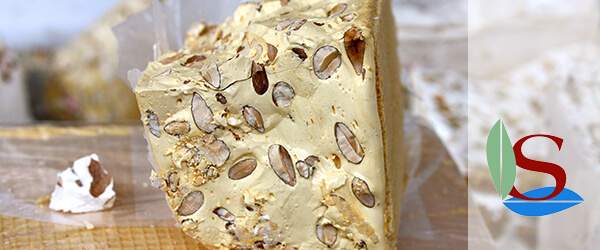Not far from Fordongianus, towards interior at Mount Mungianedda's foot there is Tonara and takes origin from 3 old districts: Arasulè, Teleseri and Toneri

About an hour by car from Fordongianus, moving towards the Sardinia's interior, at the Mount Mungianedda's foot, is located Tonara. The town takes its origin from the three ancient districts of Arasulè, Teliseri and Toneri, the last takes its name from the Sardinian word "torrioni", in limestone clusters memory in the area.
The Tonara's inhabited centre is characterized by stone buildings with wooden balconies; the country's economy is based on craft of tapestry rugs, on wood processing and the famous nougat production, to which is dedicated to a festival that takes place on Easter Monday. From this village surrounded by forests departed the torronai to bring this sweet in all the Sardinia's festivals.
Today in this country there is the Pili nougat factory, which continues to produce this delicious cake in the traditional way, by selecting the best ingredients, dried fruits, honey, chocolate and adding a bit of novelty as lemon nougat or myrtle nougat.
The Pili nougat factory is located in Via Vittorio Emanuele, 68 in Tonara.
From Tonara you move at the Mount Orohole's foot, in Ovodda. The surrounding area is rich in archaeological finds from the prehistoric era as the Domosnovas and Pedras Fittas menhirs.
The Ovodda's historic centre worth a visit for its colorful murals found in various country's places; this spot is also known around the world for the quality of the granite that is found in the two Sa Orroda and Su Ghirone quarries.
Although the country's economy is based on craft activities and agri-food, wide is the production of typical breads and pastries, including the famous carasau, also known as paper music for the sound it produces when it breaks.
One of the largest producers of this product is the bakery Santu Predu, which only uses flour coming from Sardinian grain, milled directly by an incessant work of an old stone mill.
The Bakery Santu Predu is located in Via Taloro 53.
From Ovodda you switch to Sorgono, which is located in a valley at the Gennargentu foot, surrounded by a luxuriant vegetation of holm oak, cork oak, chestnut and hazelnut trees and frequented by foxes, wild boar, mouflon, weasels, hares, eagles and peregrine falcons.
The human presence in the area dates back to Prenuraghic, as demonstrated by the various archaeological sites in the area, including that of Biru'e Concas, one of the most interesting island's menhirs. Noteworthy is also the San Mauro's sanctuary, one of the oldest rural churches. The building is covered by a single barrel vault, it houses a Baroque altar; the facade is decorated with a gray trachyte and a carved rose window , one of the most beautiful Sardinia's Gothic perio . The sanctuary is surrounded by a cumbessias fence, buildings for the rest of the pilgrims who, over the centuries, have left inscriptions on the church's stones in memory of the visit.
In the village are visible the seventeenth-century's Casa Carta's remains and a Pisan origin's source.
The country is renowned for its wine tradition, here is produced, in fact, Mandrolisai or Maristellu, a wine made from grapes Cannonau, Monica di Sardegna and Bovale.
Sorgono hosts the Cantina Mandrolisai, which takes its name from the region in which it was born in the mid-1900s. Its wine vocation has ancient origins and is due to its special climatic and environmental characteristics, with the land of high hills, well-exposed and sunny that guarantee a perfect grapes ripening even in cooler vintages. Among the best wines from the cellar there are Kent'Annos, a Mandrolisai Superiore DOC with intense ruby red color and rich and spicy aroma, il Granito Rosso, an Isola dei Nauraghi with , the Granito Bianco, always an Isola dei Nauraghi with white berry; just to name a few.
The Cantina del Mandrolisai is located in Sorgono in Corso IV Novembre, 20.